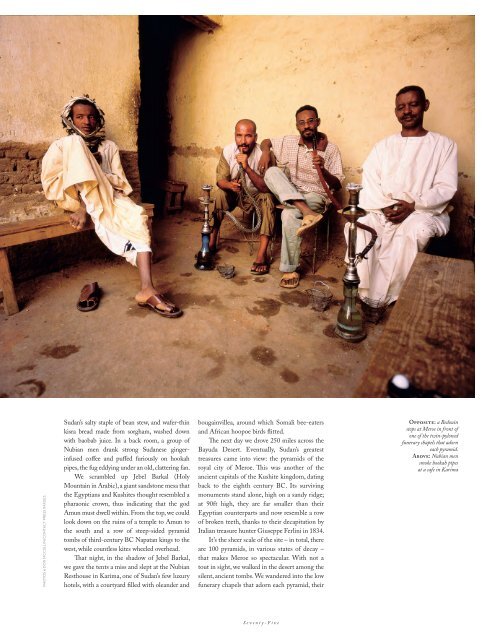Download - PrivatAir
Download - PrivatAir
Download - PrivatAir
Create successful ePaper yourself
Turn your PDF publications into a flip-book with our unique Google optimized e-Paper software.
PHOTOS©DONMCCULLIN/CONTACTPRESSIMAGES<br />
Sudan’s salty staple of bean stew, and wafer-thin<br />
kisra bread made from sorgham, washed down<br />
with baobab juice. In a back room, a group of<br />
Nubian men drank strong Sudanese gingerinfused<br />
coff ee and puff ed furiously on hookah<br />
pipes, the fug eddying under an old, clattering fan.<br />
We scrambled up Jebel Barkal (Holy<br />
Mountain in Arabic), a giant sandstone mesa that<br />
the Egyptians and Kushites thought resembled a<br />
pharaonic crown, thus indicating that the god<br />
Amun must dwell within. From the top, we could<br />
look down on the ruins of a temple to Amun to<br />
the south and a row of steep-sided pyramid<br />
tombs of third-century BC Napatan kings to the<br />
west, while countless kites wheeled overhead.<br />
Th at night, in the shadow of Jebel Barkal,<br />
we gave the tents a miss and slept at the Nubian<br />
Resthouse in Karima, one of Sudan’s few luxury<br />
hotels, with a courtyard fi lled with oleander and<br />
bougainvillea, around which Somali bee-eaters<br />
and African hoopoe birds fl itted.<br />
Th e next day we drove 250 miles across the<br />
Bayuda Desert. Eventually, Sudan’s greatest<br />
treasures came into view: the pyramids of the<br />
royal city of Meroe. Th is was another of the<br />
ancient capitals of the Kushite kingdom, dating<br />
back to the eighth century BC. Its surviving<br />
monuments stand alone, high on a sandy ridge;<br />
at 90ft high, they are far smaller than their<br />
Egyptian counterparts and now resemble a row<br />
of broken teeth, thanks to their decapitation by<br />
Italian treasure hunter Giuseppe Ferlini in 1834.<br />
It’s the sheer scale of the site – in total, there<br />
are 100 pyramids, in various states of decay –<br />
that makes Meroe so spectacular. With not a<br />
tout in sight, we walked in the desert among the<br />
silent, ancient tombs. We wandered into the low<br />
funerary chapels that adorn each pyramid, their<br />
Seventy-Five<br />
Opposite: a Bedouin<br />
stops at Meroe in front of<br />
one of the twin-pyloned<br />
funerary chapels that adorn<br />
each pyramid.<br />
Above: Nubian men<br />
smoke hookah pipes<br />
at a cafe in Karima


